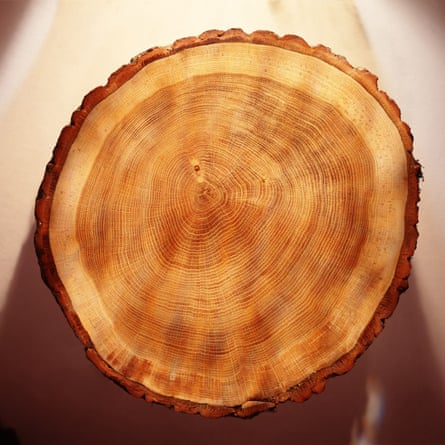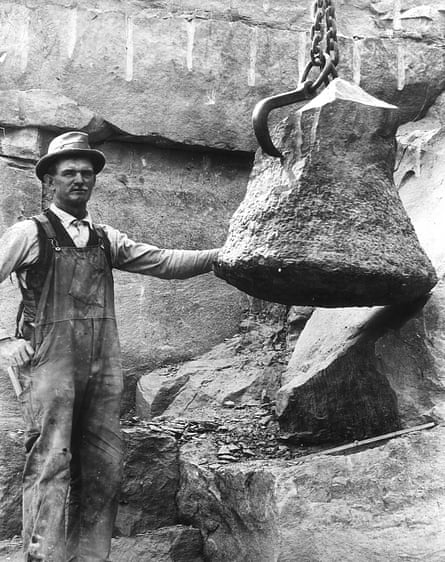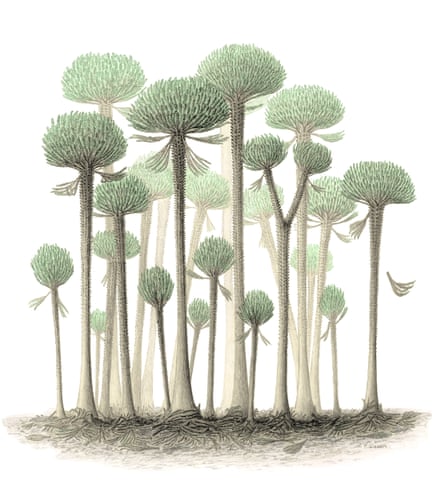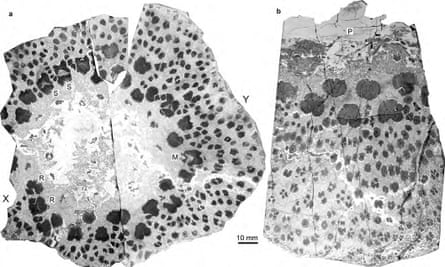In the world of knee-high land plants 400m years ago, the battle to grow tall was won by plants which found biomechanical solutions to fight gravity. Vascular plants had already evolved a plumbing system, allowing them to transport water, and the food produced by photosynthesis, around the plant. The water-conducting cells in the xylem – dead, hollow and stiffened by the polymer lignin – also afforded them some structural support. But there are limits to the height that a plant can grow with a stem of fixed girth.

In modern trees, trunks grow outwards as well as upwards. Known as secondary thickening, a ring of dividing cells beneath the bark, called the vascular cambium, produces new xylem and phloem tissue. This is what wood is: secondary xylem, composed of dead lignified cells, now employed by trees as a building material to allow them to continue to grow tall.
Plants producing wood locked up carbon extracted from the atmosphere during photosynthesis and, when trees died, resulted in its burial in sediments. This storage over geological time as coal (which humans are so keen to dig up, burn and release the carbon from) changed how carbon cycled through our ecosystems. The first forests transformed our planet in other, less obvious, ways too. Tree root systems stabilised soil, changing the landscape and affecting how minerals in the sediments weather. These changes in weathering take carbon dioxide from the atmosphere, producing carbonic acid, which ends up in river systems, and ultimately puts the carbon in the ocean. The Earth’s carbon cycle, climate and the evolution of forests are inextricably linked.
How did the first trees solve their engineering challenge? Some of them used the same strategy as modern trees. Archaeopteris (not to be confused with the much more famous Jurassic bird Archaeopteryx) was one of the earliest trees, appearing in the Late Devonian, around 380 millon years ago, and found world-wide. Up to 20 metres tall, and with a trunk up to 1.5 metres in diameter, Archaeopteris has typical secondary thickening produced by a vascular cambium ring. It had seasonal growth rings like a modern temperate tree, and had flattened photosynthesising branches which could almost be described as leaves. Archaeopteris is one of several types of plant grouped together as progymnosperms: plants which had seed plant characteristics like wood production, but which still reproduced with spores.

Another group of early trees solved the structural problem of being a tree very differently. The gloriously-named cladoxylopsids first appeared around 390 Ma, and have been well-studied from sites in Germany, Scotland and USA. The fossil forest at Gilboa quarry in New York state, where tree stumps known as Eospermatopteris, preserved as sandstone casts, up to one metre in diameter, in life position, has been studied since the 1870s. These trees were reconstructed in 2007 as Wattieza, after a fossil tree complete with a palm-like crown of leafy fronds was discovered nearby.

New discoveries in China from Hong-He Xu and colleagues, from Nanjing Institute of Geology and Palaeontology, Cardiff University and Binghamton University, have revealed the strange anatomy of the trunk of cladoxylopsid trees. Where the Gilboa Wattieza trees are preserved as sandstone casts with little detail, the new fossils dating from 374Ma, from Xinjiang, China, are silicified, preserving the cellular details of their wood. They show that rather than a simple ring producing secondary tissue, cladoxylopsids had many separate and distinct xylem strands around the outside of the trunk, each one producing its own thickening rings, almost like a mini tree. An intricate network of interconnecting xylem tissue joined up the strands throughout the trunk, which was otherwise hollow.

It is the “ordinary” cortical tissue between the xylem strands which appears to have driven girth increase in these trees, by having such a high rate of cell proliferation that it pushed the ever thicker mini-trees apart, ripping the connecting xylem tissues in the process. The tree was in a state of continual, controlled internal collapse, repairing its internal tears as it grew. This seems like an incredibly over-complicated way to be a tree. Some modern palm trees do increase their girth by primary growth but in a much less complex way. Perhaps the cost of this elaborate anatomy was a factor in the demise of the cladoxylopsids, which disappear from the fossil record soon after these Chinese finds. These findings are yet another demonstration how much we still do not know about the diversity of plants and their anatomy through deep time.
Reference:
Xu, Hong-He, Berry, Christopher M., Stein, William E., Wang, Yi, Tang, Peng and Fu, Qiang 2017. Unique growth strategy in the Earth’s first trees revealed in silicified fossil trunks from China. Proceedings of the National Academy of Sciences of the United States of America 114 (45) , pp. 12009-12014.10.1073/pnas.1708241114

Comments (…)
Sign in or create your Guardian account to join the discussion